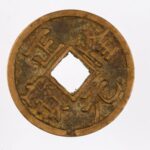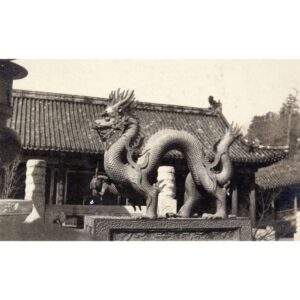Coin Zhida tongbao
A round copper alloy coin with a square hole in the centre, called fangkong qian 方孔錢. These appeared in various denominations, mostly as tongbao 通寶 (“common currency”) coins, which were worth one monetary unit, yuanbao 元寶 (“original currency”) and zhongbao 重寶 (“heavy currency”) which had higher denominations. In many varieties and denominations, such coins had been in circulation as standard money since the time of Emperor Gaozu 高祖 (reigned 618–626), the first emperor of the Tang Dynasty (618–907) until the end of the Qing Dynasty (1644–1912). The inscription on the coin usually consists of two characters, reading from top to bottom, indicating the name of the reign or the period in which the coin was minted. The other two characters are to be read from right to left. On the left-hand side of the coin is usually the character bao 寶 (wealth, preciousness), which in combination ... more
A round copper alloy coin with a square hole in the centre, called fangkong qian 方孔錢. These appeared in various denominations, mostly as tongbao 通寶 (“common currency”) coins, which were worth one monetary unit, yuanbao 元寶 (“original currency”) and zhongbao 重寶 (“heavy currency”) which had higher denominations. In many varieties and denominations, such coins had been in circulation as standard money since the time of Emperor Gaozu 高祖 (reigned 618–626), the first emperor of the Tang Dynasty (618–907) until the end of the Qing Dynasty (1644–1912). The inscription on the coin usually consists of two characters, reading from top to bottom, indicating the name of the reign or the period in which the coin was minted. The other two characters are to be read from right to left. On the left-hand side of the coin is usually the character bao 寶 (wealth, preciousness), which in combination with the character on the right means “currency” or “money in circulation”. This is usually the character tong 通 (circulate, be uniform, general or universal), but often alsoyuan 元 (origin, basis) or zhong 重 (weight), which usually denote coins with a larger face value. Thus, the entire inscription literally means “money in circulation at the time of this or that emperor” or “in this or that period of a single emperor’s reign”.
The coin in the photo comes from the Mongol Yuan Dynasty (1271–1368), when paper money, printed on paper made from bamboo fibres or mulberry bark, was the main currency in circulation. Coins from the Yuan Dynasty period are relatively rare, not only because of this predominance of paper money, but also because they were minted on a much smaller scale in this dynasty than in others. Kublai Khan, who founded the dynasty as Emperor Shizu 世祖 (reigned 1271–1294), issued coins that bore the same inscription in Mongolian script on the reverse as the usual Chinese inscription on the obverse, but this did not remain a constant practice in the production of coins throughout the dynastic period. On the obverse of this coin is the Chinese inscription Zhida tongbao 至大通寶, indicating that it was minted during the time of Emperor Kaishan, known by the Chinese title Wuzong 武宗 (reigned 1308–1311), during the period of his reign called Zhida 至大 (1310–1311), meaning “extreme greatness”. It has a blank reverse, as do most coins from this period. (MG)







































Do you have a comment or additional information about the subject?